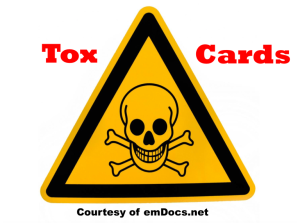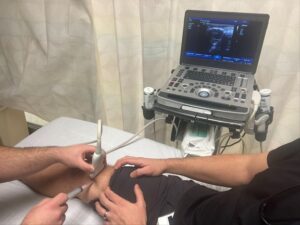Authors: Gabriela Rivera Camacho, MD, (Emergency Medicine Resident, Carolinas Medical Center, Charlotte, NC); Ann-Jeannette Geib, MD (Emergency Medicine Attending; Medical Toxicologist, Carolinas Medical Center, Charlotte, NC) // Reviewed by: Cynthia Santos, MD (@Cynthia Santos, MD); Alex Koyfman, MD (@EMHighAK); and Brit Long, MD (@long_brit)

Case presentation:
A 2-year-old otherwise healthy (11.3 kg) female presented to the ED for evaluation of an accidental ingestion. The grandmother found approximately 20 pills were missing from her levothyroxine 137 mcg bottle (2,740 mcg). The patient does not have any symptoms.
Time of exposure: 2 days ago.
Vital Signs: T 99 HR 120 BP 95/60 RR 25 Sat 99% on room air Glucose 100
Questions:
- What are the toxic doses of T3 versus T4?
- How do you treat thyroid hormone medication overdose?
Background:
- Thyroid hormones are tyrosine molecules with iodine substitutions. Two forms of the hormone are physiologically active: T3 and T4. Liothyronine (T3) and Levothyroxine (T4) are synthetic forms of the hormone.[1] T3 is approximately 4 times as potent as T4.
- Thyroid hormones are critical for optimal physiologic growth and function. Synthesis of thyroid hormones is a multistep process that occurs in the follicles of the thyroid gland, where absorbed iodide (I–) is oxidized to iodine (I2). Iodine rapidly iodinates tyrosine residues to form T3 and T4. Approximately 95% of circulating thyroid hormone is T4; the remainder is T3. Both are carried by thyroglobulin to the peripheral tissues, where T4 is converted to T3 and rT3, which has no biologic activity. [1, 2]
- Synthetic thyroid hormones are a commonly prescribed medication and exposure can cause varying severity and onset of symptoms depending on the type of hormone ingested.[1]
- Generally, ingestions greater than 3 grams of levothyroxine, or 0.75 mg (750 mcg) liothyronine have the potential to cause symptoms. Toxicity from liothyronine (T3) appears mainly in connection with subacute to chronic use of improperly compounded T3 preparations; reports of acute overdose are virtually unfounded.[3]
Medication Properties:
- Liothyronine (T3) and Levothyroxine (T4) are well absorbed via the gastrointestinal tract, have large volumes of distribution, and are highly protein-bound (99%).[1]
- T3 is four times more potent than T4.[1]
- Desiccated thyroid hormones are available by prescription or in nutritional supplements. They contain variable amounts of T3 and T4 and therefore have inconsistent potency and pharmacokinetics.[4] Thyrotoxicosis has been reported with use of these products, and their use in treating hypothyroidism is generally considered obsolete.[5]
Clinical Manifestations:
- Levothyroxine is the most common ingestion and symptoms can occur 3 to 5 days after acute ingestion. T3 can cause symptoms more rapidly, from 12 to 24 hours after acute ingestion.[6,7] This clinical latency is secondary to the delay of peripheral conversion of T4 to T3 and the time required to activate nuclear receptors and protein synthesis.[1]
- Reports of severe toxicity are rare.[1]
- Think of what to expect with thyroid storm:
- Hyperthermia
- Altered mental status
- Seizures
- Tremors
- Dysrhythmias
- Hypotension
- High output cardiac failure
- Gastrointestinal upset
- Multiorgan failure
Monitoring and Diagnosis:
- Cardiac monitor, EKG, frequent neurologic assessments.
- Consider point-of-care cardiac ultrasound to assess cardiac function in tachycardia patients.
- Signs and symptoms following thyroid hormone ingestion correlate poorly with the amount ingested, and will be delayed.
- Measured T3 and T4 correlates poorly with the degree of signs and symptoms.
- Clinical and laboratory findings early in the course of the ingestion are not reliable indicators of which patients will become ill.[1]
Management:
- Supportive care with judicious IV fluids, antiemetics for vomiting, benzodiazepines for agitation or seizures, and cooling for hyperthermia.
- Decontamination: charcoal 1gm/kg if the patient is protecting the airway or via an orogastric tube if intubated.
- Enhanced elimination: No role for multi-dose activated charcoal. Hemodialysis is not useful. Plasmapheresis has been considered in severe toxicity but seems to have mixed results in case reports and may not be readily available in all institutions.[8] Consult a toxicologist for management advice in these instances.
- Specific treatment of an overdose is targeted at inhibiting peripheral effects of thyroid hormone: in adults, 1 to 2 mg IV propranolol every 10 to 15 minutes or 20 to 120 mg PO propranolol every 6 hours (0.8mg/kg). Pediatric dosing: 0.5-4 mg/kg/d po divided every 6 hours or 0.01-0.02 mg/kg IV over 10 minutes.[1,9,10]
- Treatment with antithyroid drugs such as methimazole, PTU, iodine, or corticosteroids are generally not indicated as adjunctive therapies for the treatment of exogenous thyroxine overdose because they mainly target de novo synthesis or release, and not peripheral conversion. However, in excessive ingestions, PTU and steroids can be tried to achieve further peripheral T4 conversion.[1,9,10]
- Disposition should be dictated by the intentionality of the overdose and the patient’s ability to return to medical care should symptoms begin. Be mindful that observation is required beyond the initial ED visit. [1,9,10]
Main Points:
- Synthetic thyroid hormone overdose causes symptoms of thyrotoxicosis, although patients are expected to be asymptomatic the first hours after acute ingestion. Expectant management and anticipatory guidance should be given.
- T3 is more potent and if ingested, will cause symptoms more rapidly than T4.
- Treatment consists of supportive care, charcoal, propranolol, and sedation.
Case continuation:
The child’s thyroid function tests (TFTs) are normal.
The child is eating and drinking and behaving “same as usual”. She was observed in the ED and remained asymptomatic. She was discharged and remained asymptomatic at 4 days post-ingestion when followed up by her pediatrician.
References:
- Bouchard NC. Thyroid and Antithyroid Medications. In: Nelson LS, Howland M, Lewin NA, Smith SW, Goldfrank LR, Hoffman RS. eds. Goldfrank’s Toxicologic Emergencies, 11e New York, NY: McGraw-Hill; http://accessemergencymedicine.mhmedical.com.libproxy.lib.unc.edu/content.aspx?bookid=2569§ionid=210272832. Accessed June 02, 2020.
- Desai M, Irani AJ, Patil K, Pandya CS. The importance of reverse triiodothyronine in hypothyroid children on replacement treatment. Arch Dis Child. 1984 Jan;59(1):30-5. doi: 10.1136/adc.59.1.30. PMID: 6696490; PMCID: PMC1628409.
- He ZH, Li Y, Trivedi N, Gill S, Hennessey JV. Thyrotoxicosis after massive triiodothyronine (LT3) overdose: a coast-to-coast case series and review. Drugs Context. 2020 Jan 15;9:2019-8-4. doi: 10.7573/dic.2019-8-4. PMID: 32158485; PMCID: PMC7048132
- Kang GY, Parks JR, Fileta B, Chang A, Abdel-Rahim MM, Burch HB, Bernet VJ. Thyroxine and triiodothyronine content in commercially available thyroid health supplements. Thyroid. 2013 Oct;23(10):1233-7. doi: 10.1089/thy.2013.0101. Epub 2013 Sep 14. PMID: 23758055.
- Mcaninch EA, Bianco AC. The History and Future of Treatment of Hypothyroidism. Annals of Internal Medicine. 2016;164(1):50. doi:10.7326/m15-1799.
- Levothyroxine. POISINDEX® System (electronic version). IBM Watson Health, Greenwood Village, Colorado, USA. Available at: https://www.micromedexsolutions.com. Accessed June 02, 2020.
- Liothyronine. POISINDEX® System (electronic version). IBM Watson Health, Greenwood Village, Colorado, USA. Available at: https://www.micromedexsolutions.com. Accessed June 02, 2020.
- Jha S,. Waghdhare S, Reddi R., Bhattacharya P. Thyroid storm due to inappropriate administration of a compounded thyroid hormone preparation successfully treated with plasmapheresis. Thyroid. 2012 Dec;22(12):1283-6. Epub
- Burch H.B., Wartofsky L. Life-threatening thyrotoxicosis. Thyroid storm. Endocrinol Metab Clin North Am. 1993;22(2):263
- Brunette D.D., Rothong C. Emergency department management of thyrotoxic crisis with esmolol. Am J Emerg Med. 1991;9(3):232.







